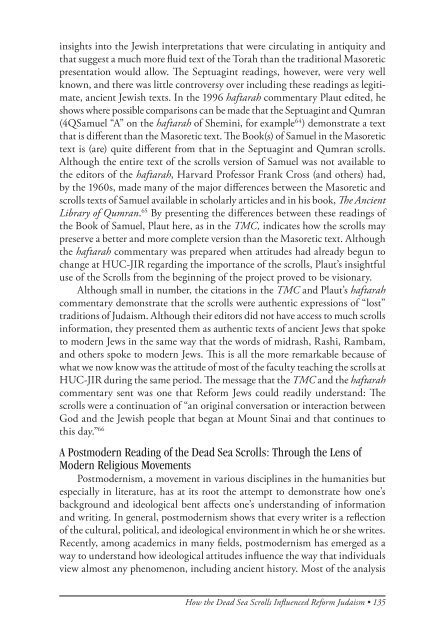The American Jewish Archives Journal, Volume LXI 2009, Number 1
The American Jewish Archives Journal, Volume LXI 2009, Number 1
The American Jewish Archives Journal, Volume LXI 2009, Number 1
You also want an ePaper? Increase the reach of your titles
YUMPU automatically turns print PDFs into web optimized ePapers that Google loves.
insights into the <strong>Jewish</strong> interpretations that were circulating in antiquity and<br />
that suggest a much more fluid text of the Torah than the traditional Masoretic<br />
presentation would allow. <strong>The</strong> Septuagint readings, however, were very well<br />
known, and there was little controversy over including these readings as legitimate,<br />
ancient <strong>Jewish</strong> texts. In the 1996 haftarah commentary Plaut edited, he<br />
shows where possible comparisons can be made that the Septuagint and Qumran<br />
(4QSamuel “A” on the haftarah of Shemini, for example 64 ) demonstrate a text<br />
that is different than the Masoretic text. <strong>The</strong> Book(s) of Samuel in the Masoretic<br />
text is (are) quite different from that in the Septuagint and Qumran scrolls.<br />
Although the entire text of the scrolls version of Samuel was not available to<br />
the editors of the haftarah, Harvard Professor Frank Cross (and others) had,<br />
by the 1960s, made many of the major differences between the Masoretic and<br />
scrolls texts of Samuel available in scholarly articles and in his book, <strong>The</strong> Ancient<br />
Library of Qumran. 65 By presenting the differences between these readings of<br />
the Book of Samuel, Plaut here, as in the TMC, indicates how the scrolls may<br />
preserve a better and more complete version than the Masoretic text. Although<br />
the haftarah commentary was prepared when attitudes had already begun to<br />
change at HUC-JIR regarding the importance of the scrolls, Plaut’s insightful<br />
use of the Scrolls from the beginning of the project proved to be visionary.<br />
Although small in number, the citations in the TMC and Plaut’s haftarah<br />
commentary demonstrate that the scrolls were authentic expressions of “lost”<br />
traditions of Judaism. Although their editors did not have access to much scrolls<br />
information, they presented them as authentic texts of ancient Jews that spoke<br />
to modern Jews in the same way that the words of midrash, Rashi, Rambam,<br />
and others spoke to modern Jews. This is all the more remarkable because of<br />
what we now know was the attitude of most of the faculty teaching the scrolls at<br />
HUC-JIR during the same period. <strong>The</strong> message that the TMC and the haftarah<br />
commentary sent was one that Reform Jews could readily understand: <strong>The</strong><br />
scrolls were a continuation of “an original conversation or interaction between<br />
God and the <strong>Jewish</strong> people that began at Mount Sinai and that continues to<br />
this day.” 66<br />
A Postmodern Reading of the Dead Sea Scrolls: Through the Lens of<br />
Modern Religious Movements<br />
Postmodernism, a movement in various disciplines in the humanities but<br />
especially in literature, has at its root the attempt to demonstrate how one’s<br />
background and ideological bent affects one’s understanding of information<br />
and writing. In general, postmodernism shows that every writer is a reflection<br />
of the cultural, political, and ideological environment in which he or she writes.<br />
Recently, among academics in many fields, postmodernism has emerged as a<br />
way to understand how ideological attitudes influence the way that individuals<br />
view almost any phenomenon, including ancient history. Most of the analysis<br />
How the Dead Sea Scrolls Influenced Reform Judaism • 135

















